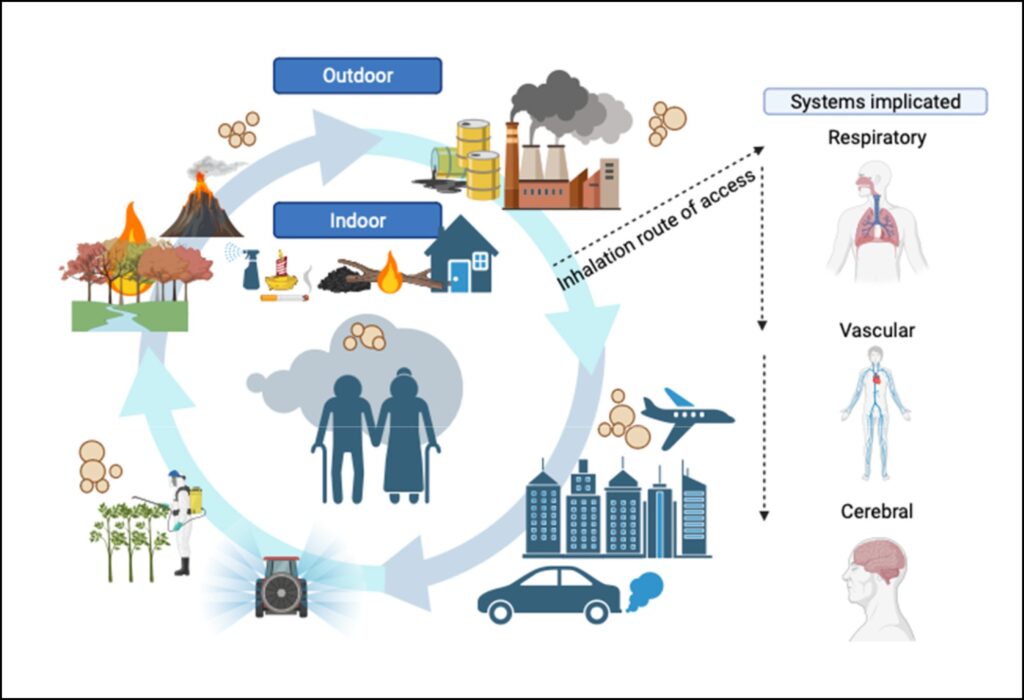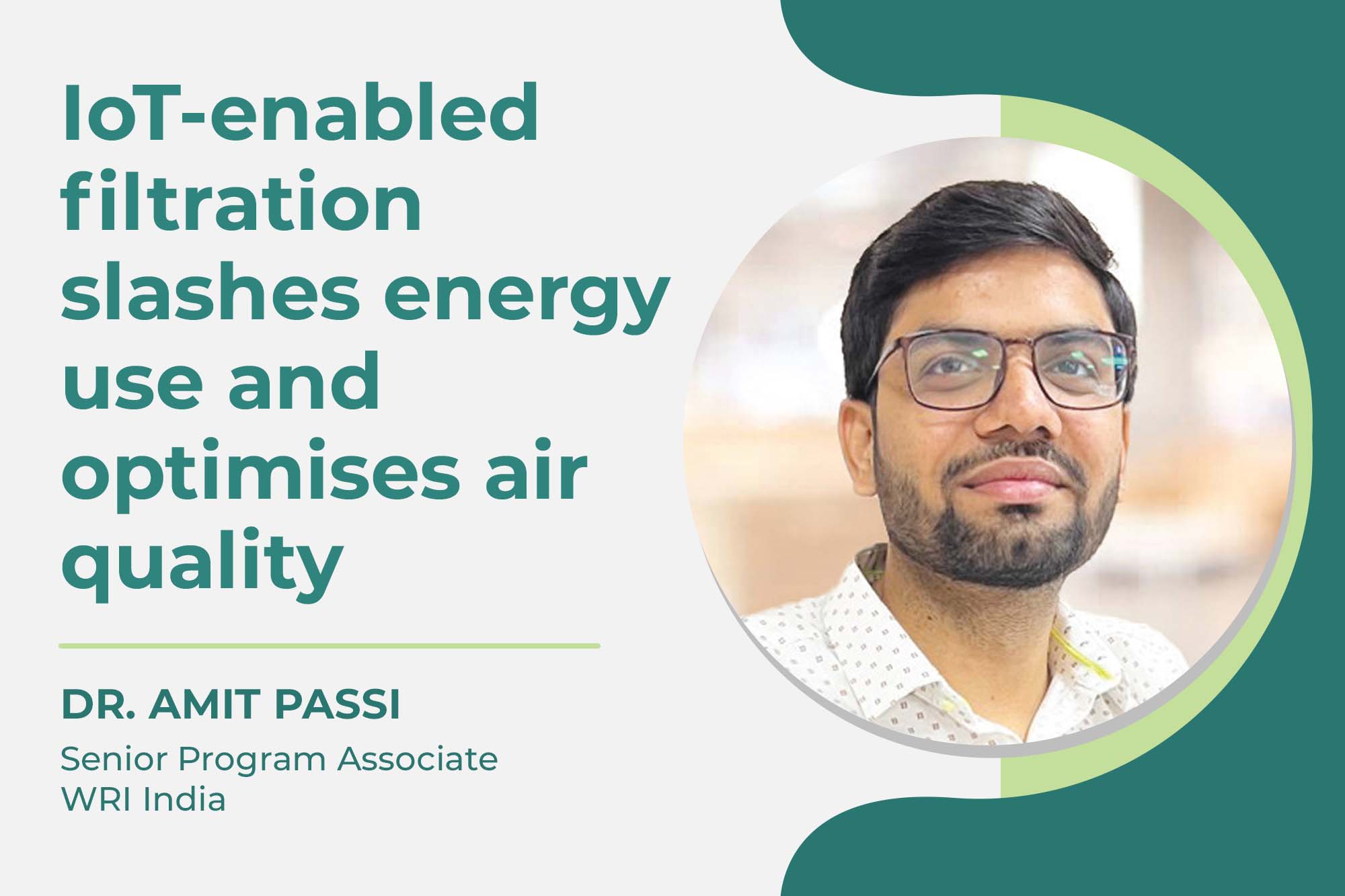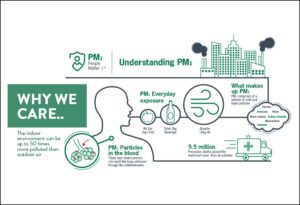IoT-enabled filtration slashes energy use and optimises air quality
Air pollution, both indoor and outdoor, poses severe health and environmental risks. Addressing its sources through strategic interventions, smart technologies, urban planning, and behavioral change is essential. Dr. Amit Passi, Senior Program Associate at WRI India, explores integrated approaches to monitor, manage, and mitigate airborne pollutants for healthier, more sustainable living environments.
What strategies can be employed to mitigate the sources of indoor and outdoor airborne pollutants?
Indoor airborne pollutants can originate from various sources, including combustion activities such as cooking, heating, and smoking; household items like personal care and cleaning products; building materials; and furnishings (including insulation, flooring, paints, varnishes, carpets, and furniture). Although ventilation and HVAC systems are designed to improve indoor air quality, they can become sources of pollution themselves if not properly maintained.
The primary sources of outdoor airborne pollutants include combustion processes from vehicles, industries using fossil fuels, resuspended road dust, construction activities, the open burning of solid waste and crop residue, and natural sources (such as dust storms, open fires, pollen, and spores).
The best way to manage indoor and outdoor air pollutants is to mitigate them at the source through various strategies such as capturing pollutants, transitioning to cleaner fuels and cleaner technologies, etc.
Indoor air contaminants are controlled through source control, ventilation, and air filtration or purification. This is helpful to maintain good indoor hygiene. Consider using low-VOC building materials and ventilating your home regularly, either naturally or with mechanical systems. Using exhaust fans in kitchens and bathrooms can improve airflow. Opting for non-toxic cleaning products and using air purifiers may support better air quality. Regular servicing of air conditioners is also beneficial. Limit the usage of incense sticks, air fresheners, and scented goods in closed and poorly ventilated areas. Prevent leaks in the building or AC systems. Tools, such as low-cost monitors, may be deployed to measure and manage indoor air quality.
Managing outdoor air pollution requires a coordinated multiprong strategy. Emissions can be minimised through the capture of pollutants. Combustion sources can minimise emissions by using cleaner fuels and/or employing cleaner and more efficient combustion technologies. Emissions from construction activities can be minimised by using clean construction practices. Reducing the use of private vehicles and adopting public transit will help minimise traffic congestion.
These measures, combined with incentives, regulatory compliance, enforcement, investments in infrastructure like enhanced waste management systems, and long-term planning, will contribute to improved air quality.
How does long exposure to particulate matter like PM2.5 and PM10 impact children and adults?
Long-term exposure to PM2.5 and PM10 causes serious health issues in children and the elderly, especially people with pre-existing medical conditions. It also impacts healthy adults with chronic diseases.
In children and adolescents, long-term exposure to particles in the air during the formative and developmental years can lead to respiratory disorders, asthma, allergic reactions, pneumonia, neurodevelopmental impairment, cognitive impairment, and exacerbated chronic conditions. (European Environment Agency).
In adults, long-term exposure to particles causes COPD (chronic obstructive pulmonary disease), IHD (ischemic heart disease), lung cancer, stroke, and pneumonia (World Health Organisation). It also increases blood pressure, is linked to dementia, and increases the risk of mortality. Also, long exposure is very harmful to pregnant women, resulting in low birth weight, premature birth, and stillbirth/late fetal death (National Institute of Health).
Please discuss filtration systems and IoT technology to optimise indoor environments and minimise energy consumption.
The integration of filtration systems and IoT technologies reduces energy usage. It allows for real-time monitoring of contaminants and regulates HVAC and air filtration systems. HVAC and air filtration systems connected to the IoT can be programmed to adapt automatically in response to surrounding environmental conditions, optimizing HVAC operation for pollutant control and reducing energy consumption considerably.

Source: López-Granero et al. (2023). https://doi.org/10.3390/biom14010035
How can outside air be conditioned to improve ventilation and air exchange within indoor spaces?
The outside air can be conditioned through air filtration, temperature, and humidity control to enhance ventilation and air exchange in indoor spaces. The use of high-efficiency filters in HVAC systems and portable air purifiers can further improve overall air quality. Moreover, installing green infrastructure in the surrounding areas may serve as a barrier to minimize wind-blown dust and reduce pollution from entering from the outside.
Which monitoring tools and filter standards mark a shift to address air quality concerns?
Air quality concerns are addressed using a range of monitoring tools, including fixed and portable air quality monitors, a low-cost sensor network, remote sensing or satellite-based sensing observations, and crowdsourced data using a citizen science approach.
The ISO 16890 standard marked a shift in measuring air filters’ ability to capture PM1, PM2.5, and PM10 particles. It applies to general ventilation filters with PM1 efficiency ≤99%.
ASHRAE 52.2-2017 recommends using a HEPA or ULPA filter for initial testing to ensure the system can measure greater than 99% efficiency. HEPA filters remove 99.97% of particles ≥0.3 μm, while ULPA filters offer 99.9995% efficiency for particles ≥0.12 μm.
What innovations are integrating UV technology for disinfection into HVAC systems?
Incorporating ultraviolet germicidal irradiation (UVGI) into HVAC systems can effectively reduce airborne microorganisms, mold, bacteria, and viruses. UV light is categorised into UV-A (315–400 nm), UV-B (280–315 nm), and UV-C (100–280 nm). UV-C, the most energetic and fully absorbed by the ozone layer, is commonly used in germicidal lamps to disinfect air handling units, ductwork, and cooling coils.
Integrating UV-C with IoT and smart controls enables real-time monitoring, automated maintenance, and enhanced energy efficiency. The use of UV radiation increases the risk of ozone generation, which is harmful to health. The UV-A band has a lower likelihood of ozone formation. Therefore, the use of irradiation technologies also requires close monitoring of ozone and particle concentrations to optimise indoor air quality. However, UV-A light can be utilised in place of UV-C for effective bactericidal activity through prolonged exposure. While not ideal for high microbial loads, UV-A may be a safer alternative in specific contexts. However, any system using UV radiation will need to include appropriate protection measures to prevent exposure to humans.
What role can urban planning play in reducing air pollution in the context of increasing construction and urbanisation?
Urban planning plays a crucial role in reducing air pollution by incorporating building designs and constructions that enhance airflow, create open spaces, and improve air pollution dispersion. It integrates green infrastructure, such as green roofs, green walls, and green corridors, into the urban landscape, capturing pollutants and enhancing air quality. Planning infrastructure such as mass transit systems and non-motorised transport networks (footpaths, cycle tracks) can reduce reliance on private vehicles, significantly lowering vehicular emissions. Hong Kong’s mass transit system, which includes residential and commercial development, exemplifies good urban planning. Urban planning also protects ecologically sensitive areas, including wetlands, forests, and water bodies, which act as natural sinks for pollutants and help regulate the local climate.
How can public awareness campaigns influence behavior towards air pollution?
Public awareness is crucial in promoting behavioral change that reduces air pollution exposure and anthropogenic emissions to improve air quality. It encourages the use of active transportation (walking and cycling) and public transportation, as well as the adoption of LPG or induction stoves. It ensures safety measures are implemented at construction sites, among other measures. Increased public awareness can shift how people view and respond to air pollution. Research shows that characteristics such as age, gender, education and health literacy, mental health, financial status, social preferences, and societal influences shape individual behavior. These factors affect how people interact with their environment. Behavior change initiatives enable people to lessen their environmental impact by making lifestyle changes and making better decisions.
Cookie Consent IAQ India
We use cookies to personalize your experience. By continuing to visit this website you agree to our Terms & Conditions, Privacy Policy and Cookie Policy.




